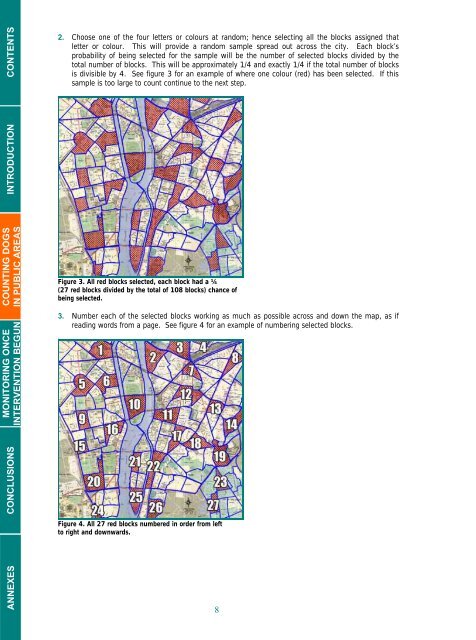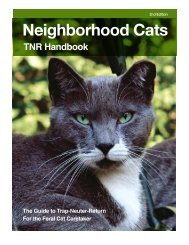Surveying roaming dog populations: guidelines ... - Animal Sheltering
Surveying roaming dog populations: guidelines ... - Animal Sheltering
Surveying roaming dog populations: guidelines ... - Animal Sheltering
You also want an ePaper? Increase the reach of your titles
YUMPU automatically turns print PDFs into web optimized ePapers that Google loves.
CONTENTS<br />
2. Choose one of the four letters or colours at random; hence selecting all the blocks assigned that<br />
letter or colour. This will provide a random sample spread out across the city. Each block’s<br />
probability of being selected for the sample will be the number of selected blocks divided by the<br />
total number of blocks. This will be approximately 1/4 and exactly 1/4 if the total number of blocks<br />
is divisible by 4. See figure 3 for an example of where one colour (red) has been selected. If this<br />
sample is too large to count continue to the next step.<br />
COUNTING DOGS<br />
IN PUBLIC AREAS<br />
MONITORING ONCE<br />
INTERVENTION BEGUN<br />
Figure 3. All red blocks selected, each block had a ¼<br />
(27 red blocks divided by the total of 108 blocks) chance of<br />
being selected.<br />
3. Number each of the selected blocks working as much as possible across and down the map, as if<br />
reading words from a page. See figure 4 for an example of numbering selected blocks.<br />
CONCLUSIONS<br />
INTRODUCTION<br />
Figure 4. All 27 red blocks numbered in order from left<br />
to right and downwards.<br />
ANNEXES<br />
8








